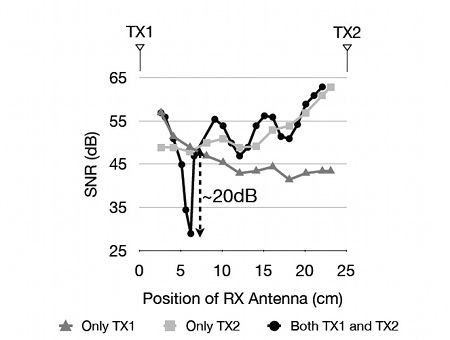Full-duplex transmission could double speed of wireless networks
Feb 18, 2011 — by LinuxDevices Staff — from the LinuxDevices Archive — viewsStanford University researchers have announced a breakthrough that could nearly double the throughput of wireless networks. The “antenna cancellation” technology has already been demonstrated in office settings and, once perfected, will add little cost to Wi-Fi equipment, according to the university.
 The new technique for achieving single-channel, full-duplex wireless communication was apparently first revealed in a paper [PDF link] at last fall's ACM (Association for Computing Machinery) MobiCom 2010 conference in Chicago, but came to the world's attention this week via a release by the Stanford University press office. It's the work of two Stanford assistant professors, Philip Levis (near right) and Sachin Katti (far right), as well as graduate students Jung Il Choi, Mayank Jain, and Kannan Srinivasan.
The new technique for achieving single-channel, full-duplex wireless communication was apparently first revealed in a paper [PDF link] at last fall's ACM (Association for Computing Machinery) MobiCom 2010 conference in Chicago, but came to the world's attention this week via a release by the Stanford University press office. It's the work of two Stanford assistant professors, Philip Levis (near right) and Sachin Katti (far right), as well as graduate students Jung Il Choi, Mayank Jain, and Kannan Srinivasan.
In a newly created summary, the team members explain that existing wireless systems presume that it's impossible to transmit and receive at the same time and on the same channel. Therefore, the systems either use time to multiplex the channel (alternating transmitting and receiving), or use two separate channels (frequencies), one for transmission and one for reception.
The problem that has historically prevented full-duplex operation on a single frequency, they add, is that if a node is transmitting, its own signal is millions of times stronger than other signals it might hear, "like trying to hear a whisper while shouting." Digital cancellation circuits can reduce the apparent strength of the transmitted signal, but not enough to make a node able to receive, the team says.
The researchers came up with a solution to this problem that is simple — "so simple and effective it won't work," Levis quotes a colleague as having warned. Essentially, the antenna cancellation technique works with radio waves much the same way noise-canceling headphones do with sound waves.
According to the team, devices such as wireless access points would use two transmitting antennas. A single receiving antenna would then be positioned between them such that the signals from the two transmit antennas reach it exactly 180 degrees out of phase, canceling each other out.

A receiving antenna may be mounted between two transmitting ones, canceling out interference
(Click to enlarge)
When the proper point for the receiving antenna is found, interference from the device's transmitter is cut down by from 20 to 30dB, as shown in the graphic above. In combination with existing digital interference cancellation techniques, this could be improved on by another 30dB or so, the researchers say, allowing a node to simultaneously transmit and receive.
Antenna cancellation does have some limitations, the researchers concede, for example. For example, "very strong transmitters cannot be canceled," and "Wi-Fi is just within the realm of possibility," they write.
The technique also has physical limitations in that antennas must be spaced apart by at least half the wavelength of whatever frequency is being used. The researchers say their 2.4GHz prototype device used about seven inches of space for antenna placement, meaning that while the solution could work for an access point or on a laptop body, it would not easily fit in a PCI Express wireless card.
According to the Stanford team, their tests of antenna cancellation show that full-duplex networks using it achieved 85 percent better throughput than their half-duplex equivalents. However, low-power 802.15.3 (ZigBee) networking was used, and it's not yet clear if the technique can be used in 802.11 networks, which have transmit power that's four times higher and bandwidth that's four times as wide.
It also appears that full-duplex networking would be of relatively little value in situations where traffic is inherently asymmetrical — a typical web browsing scenario, in fact. It could come into its own, however, for networks that are truly peer-to-peer, such as the proximal FlashLinq technology shown off by Qualcomm earlier this week.
Ultimately, according to Levis, upgrading Wi-Fi access points to take advantage of full-duplex networking would require another antenna, at a cost of about 30 or 40 cents, plus a custom chip to do hardware noise cancellation.
The team concludes, "With new media access control (MAC) layer designs that support full duplex, some of the most challenging problems in wireless networks can be mitigated, including hidden terminals, congestion, and end-to-end delay in multihop networks."
Antenna cancelation in action
Source: Stanford University
(click to play)
This article was originally published on LinuxDevices.com and has been donated to the open source community by QuinStreet Inc. Please visit LinuxToday.com for up-to-date news and articles about Linux and open source.